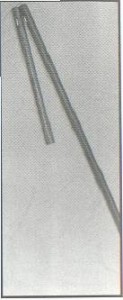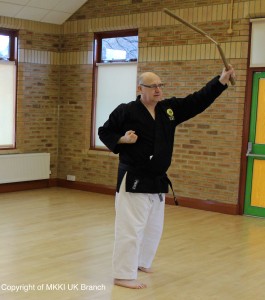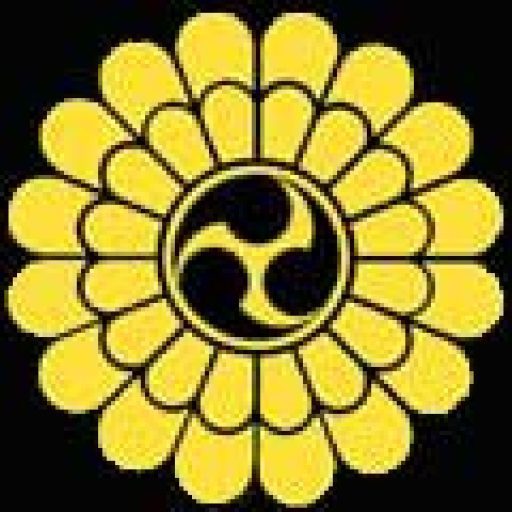Below is the fifth article that was published in the MAI magazine about Matyoshi Kobudo.
Introduction
 The Nunchaku is a traditional Okinawan weapon used in schools of Kobudo and some Karate. They are one of my favourite weapons to study as it takes a great deal of practice and skill to be able to use them. Because of the nature of the weapon where you have a flying stick which is swung around your body is dangerous in the unskilled hands. Over the years I have seen and had my fair share of strikes by the flying shaft when the technique is not correctly executed. It is for this reason that I have always said that the Nunchaku teaches you, because if you make a mistake you will not make it again. The most common mistakes are those from the execution of the weapon where the practitioner is only thinking of “juggling” the weapon and not of striking the opponent; consequently they eventually hit themselves.
The Nunchaku is a traditional Okinawan weapon used in schools of Kobudo and some Karate. They are one of my favourite weapons to study as it takes a great deal of practice and skill to be able to use them. Because of the nature of the weapon where you have a flying stick which is swung around your body is dangerous in the unskilled hands. Over the years I have seen and had my fair share of strikes by the flying shaft when the technique is not correctly executed. It is for this reason that I have always said that the Nunchaku teaches you, because if you make a mistake you will not make it again. The most common mistakes are those from the execution of the weapon where the practitioner is only thinking of “juggling” the weapon and not of striking the opponent; consequently they eventually hit themselves.
I saw this weapon for the first time in the famous Bruce Lee film Enter the Dragon back in 1973. Except for Judo, this was the first time I had seen any form of martial art and was immediately mesmerised with Karate. But it was a long time before I started training with Nunchaku, in fact not until the early 90’s. In this film he used two Nunchaku, but traditionally the weapon is used singularly. Since then they have appeared in many other films and TV shows, such as by Michelangelo who is one of the Teenage Ninja Turtles.
 The Nunchaku sometimes referred to as Nunchuks in English, was developed for self-defence. They can be easily concealed and are said to be still used in guerrilla war in Korea and South East Asian countries. Today they have become more popular in modern freestyle sport. Here the performer uses the Nunchaku as a visual art rather than a weapon, swing and catching the weapon in various ways. Sometimes they are swung and caught around the neck and between the legs. Although highly skilled and I would assume many hours of practice I don’t see any strikes within these skills. Now there are many sporting associations that use the Nunchaku in this way and because of inherent dangers they use the foam or rubber variety. As Matayoshi Kobudo Kodokan is steeped in tradition, the Ryu only uses the wooden variety of Nunchaku, and in the correct manner of Budo, and not in a sporting application. Hence the reason why this weapon is the forth in the series of weapons one learns. This weapon takes time to acquire the skill and to control. However, when the practitioner gains confidence with the Nunchaku I think it’s a nice weapon. But be prepared to get the occasional knocks!
The Nunchaku sometimes referred to as Nunchuks in English, was developed for self-defence. They can be easily concealed and are said to be still used in guerrilla war in Korea and South East Asian countries. Today they have become more popular in modern freestyle sport. Here the performer uses the Nunchaku as a visual art rather than a weapon, swing and catching the weapon in various ways. Sometimes they are swung and caught around the neck and between the legs. Although highly skilled and I would assume many hours of practice I don’t see any strikes within these skills. Now there are many sporting associations that use the Nunchaku in this way and because of inherent dangers they use the foam or rubber variety. As Matayoshi Kobudo Kodokan is steeped in tradition, the Ryu only uses the wooden variety of Nunchaku, and in the correct manner of Budo, and not in a sporting application. Hence the reason why this weapon is the forth in the series of weapons one learns. This weapon takes time to acquire the skill and to control. However, when the practitioner gains confidence with the Nunchaku I think it’s a nice weapon. But be prepared to get the occasional knocks!
This weapon is now illegal for anyone to carry them not unless they are being transported safely to and from the martial art school. If stopped you may also be asked to prove that you are a martial artist. In 2010 the Glasgow Sheriff Court ruled that Nunchaku fell into the category of a “prohibited weapon”. In other countries this weapon is also illegal, such as in Norway, Canada, Russia, Poland, Chile, Spain and Germany. So make sure they are in your kit bag, and if driving in the boot of the car, if transporting this weapon to and from your home to the dojo. Always carry proof that you are a martial artist just in case you get stopped.
History of the Nunchaku

Most of kobudo weapons have been developed from farmers tools, one theory tells of its development from that of a flail, known as Utzu, which is said to thrash rice or soya. The Okinawa flail has one short length of staff and one as long as a man’s height. They held one end then thrashed the rice husks or soya with the other in order to remove the husk. Rather than thrashing, another theory is thought that the Nunchaku was used to remove the rice husks from the stalks. To envisage this it was done by splitting bamboo down the middle and putting the stalks between the shafts and pulling the stalks through the split bamboo.

There are stories that the Nunchaku was invented by women in order to defend themselves from bandits or their Satsuma overlords. The tool was made from bamboo which was split down the middle and tying one end together with rope. They then used this to remove bark from the banana tree, called Abaca. This bark was then used to make waved items; the majority of this work was carried out by the women.
I think the most convincing of all these development theories is that which has originated from the Muge, horse bridle. In fact the Okinawan language “Nunchiyaku” means “Horse Bridle”. It was made of wood which was curved and strung together with rope.
However the development of the weapon came about, due to their law restraints, the Okinawans were forced into training with them in secrecy. Furthermore, because the Nunchaku was one of the most difficult weapons to learn and develop techniques for, there was not many recorded or passed down kata; in fact Matayoshi Kobudo has only one. Matayoshi Shinko Sensei learnt the Nunchaku-jutsu from Irei Sensei of Nozato Chatan village. His knowledge was passed down to his son Matayoshi Shinpo Sensei and to the instructors of the Kodokan in Okinawa.
Construction of the Nunchaku

 Traditionally the Nunchaku was made of hard wood such as red oak, where the length of the shafts do not have an specific length but it is very common to be able to find Nunchaku of 14” shafts. For taller practitioners shafts can be personalized to a longer length. Both shafts are joined together at one end with cord (himo), horse hair or women’s hair so that they could swivel from the central point. The shafts are generally tapered, cord end being around 2.5 cm to the other end of the Nunchaku being around 3.5 cm. These shafts were either square, hexagonal, octagonal (Okinawan adaptation) or round in shape. The octagonal has a greater ability to inflict more damage due to its edge. The cord holding the two shafts should be of an ideal length whereupon when laid across the users palm it should just span the palm and the two shafts would hang perpendicularly down from the hand. The shafts were strung together by triple string. The triple string Nunchaku is the safest as it has the advantage that if one cord breaks it is held by the other two. Furthermore, both shafts also need to be identical and equally well balanced. In addition to the cord there are the chain (Kusari) versions, but these chains cannot be altered to provide the required length to carry out all of the Nunchaku techniques seen in the Matayoshi Kobudo system. Also the chain version brings the risk that the metal will get worn out with the use and it will break having as a consequence that one of the shafts will fly in the air without control.
Traditionally the Nunchaku was made of hard wood such as red oak, where the length of the shafts do not have an specific length but it is very common to be able to find Nunchaku of 14” shafts. For taller practitioners shafts can be personalized to a longer length. Both shafts are joined together at one end with cord (himo), horse hair or women’s hair so that they could swivel from the central point. The shafts are generally tapered, cord end being around 2.5 cm to the other end of the Nunchaku being around 3.5 cm. These shafts were either square, hexagonal, octagonal (Okinawan adaptation) or round in shape. The octagonal has a greater ability to inflict more damage due to its edge. The cord holding the two shafts should be of an ideal length whereupon when laid across the users palm it should just span the palm and the two shafts would hang perpendicularly down from the hand. The shafts were strung together by triple string. The triple string Nunchaku is the safest as it has the advantage that if one cord breaks it is held by the other two. Furthermore, both shafts also need to be identical and equally well balanced. In addition to the cord there are the chain (Kusari) versions, but these chains cannot be altered to provide the required length to carry out all of the Nunchaku techniques seen in the Matayoshi Kobudo system. Also the chain version brings the risk that the metal will get worn out with the use and it will break having as a consequence that one of the shafts will fly in the air without control.
As the popularity in Nunchaku has grown we are seeing more varieties on the market especially in the area of free-style sport martial arts. The modern day Nunchaku can be made from various materials, for example from metal, such as aluminium; or plastics and rubber, such as nylon, and fibreglass. There are types that glow in the dark, have fluorescent tape around the shaft and some have coloured lights fitted; there are some that even make a type of Bruce Lee Kiai as it is used. They can be small with long chains and others are telescopic. Toys and one supposedly for safe practice are covered in foam rubber. A lot of the mass produced Nunchaku are painted or varnished, this tends to reduce grip making the weapon harder to handle.
As Matayoshi Kobudo is a traditional Budo system the Nunchaku is made from the hard wood, octagonal, and with a three-strung cord. Again they can be made to order, which is preferable, or if purchasing one of the mass made wooden varieties then make sure they are rubbed down with sand paper to remove any paint or varnish and then oil them with a wood preserve, such as Linseed or Tung oil. However, I would again recommend getting Nunchaku that is made for the individual practitioner. The best woods for Nunchaku that can withstand the type of bunkai, partner work that is carried out in the MKKI would be Jotoba, White Oak, Cocobola, Bloodwood, or Purpleheart.
The parts of the Nunchaku are named as follows:
- Ana: the hole on the kontoh of each shaft for the himo to pass through
- Himo: the rope which connects the two shafts
- Kontei: the top of each shaft
- Jokon-bu: the upper area of the shaft
- Chukon-bu: the centre part of the shaft
- Kikon-bu: the lower part of the shaft
- Kontei: the bottom of the shaft
- Monuchi: striking area of the shaft
- Gedan tsukagashira – end of the shaft where the rope is.
- Ushiro tsukagashira – end of the shaft furthest from the rope
Fundamentals of Matayoshi Nunchaku-jutsu
This weapon is not manipulated as in the flamboyant manner seen in martial art movies, or as in sport martial arts, but with a more practical approach. Handling the Nunchaku is difficult and requires a high degree of skill, coordination and persistence in training. The diversity of techniques of strikes, blocks and catches requires time to master. The practitioner soon learns the high degree of coordination that is required after a few bangs and crashes on the body. Because we only use the hard wood variety and not the foam safety type the novice tends to be afraid of swinging and catching these weapons. As a consequence of this the Nunchaku swings closer to the body providing a greater chance of being hit. There are not many students that I have seen that have not hit themselves with these weapons; on the elbow, leg, fingers, back and even some on the head. This is why without the correct training they can be lethal to the practitioner.
Matayoshi Kobudo teaches how to carry out these movements correctly and imparting the correct strikes. The target of the Nunchaku is the same with all kobudo weapons; these are the hands, wrist forearms, head, face, jaw, clavicle, ribs, sternum, groin and knees. They can also be used at different distances which incorporate striking, strangles and holds. To do this the practitioner trains in the Nunchaku Hojo Undo for the weapons, which teaches the distance and angles required.
 The power imparted from the Nunchaku comes from the correct movement of the hips, shoulder and wrist and movement in stance. Because the shaft that is swinging is attached to the shaft that is held by a cord it has the tendency to bounce back after hitting the target and thus striking the wielder of the weapon. The Matayoshi Kobudo teaches how to strike through, whereby the Nunchaku does not bounce back. There are exercises that are done by striking Bo or pads to teach this principal. You can see the strike and power of the Nunchaku as it makes a “Whooshing” sound through the air as the technique is performed correctly.
The power imparted from the Nunchaku comes from the correct movement of the hips, shoulder and wrist and movement in stance. Because the shaft that is swinging is attached to the shaft that is held by a cord it has the tendency to bounce back after hitting the target and thus striking the wielder of the weapon. The Matayoshi Kobudo teaches how to strike through, whereby the Nunchaku does not bounce back. There are exercises that are done by striking Bo or pads to teach this principal. You can see the strike and power of the Nunchaku as it makes a “Whooshing” sound through the air as the technique is performed correctly.
Through the kata, Nunchaku No Kata, the practitioner learns how to move from stance to stance, changing directions, executing the strikes, blocks and catches. Through the bunkai of the Hojo Undo and Kata the practitioner learns the vital Maai, distance and timing, against the various weapons they come against. As with the other weapons the practitioner learns the advantage of deflection and of posture breaking prior to their counter.
This weapon also benefits the empty hand practitioner as it increases hand speed, coordination and posture. It is important to say that the practise of Nunchaku must be maintained otherwise the skill is easily lost, but once mastered enjoyable and exciting to use.
